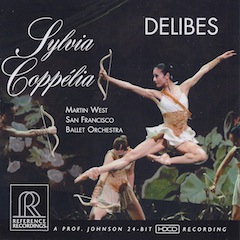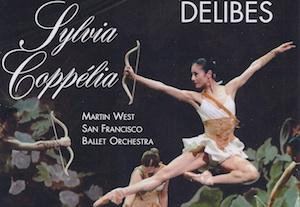
There are at least three compelling reasons to buy this recording. First, the music, suites drawn from Léo Delibes’ complete scores for the ballets Sylvia (initially produced at Théâtre de l’Opéra, Paris, in 1876) and Coppélia (Théâtre Impérial de l’Opéra, Paris, in 1870), is lively, colorful, and filled with charm. Often relegated to secondary roles at the ballet, with some of their glories compressed into the pit as dancers prance and pirouette above, the scores really come into their own when allowed to parade on their own two feet.
True, Sylvia and Coppélia are exactly the kind of fluffy divertissement that have left many a youth and elder clamoring for rock ’n’ roll and heavy metal, and convinced many an Occupier that ballet is indeed for the 1 percent who can afford to retreat to the comfort of their Napa, Atherton, Belvedere, and Pacific Heights palaces and fantasize their own private universes of fauns, dryads, shepherds, nymphs, and mechanical dolls. But for those who can accept that music such as this served as an oft-welcome antidote to the Franco-Prussian War, and who have room in their life for its charms, Sylvia and Coppélia offer one irresistibly gay tune after another.
Listen To The Music
Sylvia, suite from the ballet: ApothéoseCoppélia, suite for orchestra: Mazurka

A second reason to acquire the CD is that Martin West and his San Francisco Ballet Orchestra do a bang-up job. Comparison with two classic Mercury Living Presence renditions of the complete scores — Anatole Fistoulari’s Sylvia with the London Symphony Orchestra and Antal Doráti’s Coppélia with the Minneapolis Symphony Orchestra — finds West’s tempos broader in some key movements, and hence more conducive to listening without visuals. As for the sound of the instruments on those classic recordings, one listen to the harsh violins in Fistoulari’s Sylvia will send you running to hear San Francisco’s silken strings.
Which leads us to the third reason for hitting the “buy” tab. This latest release from Bay Area’s Reference Recordings, captured over two days at Skywalker Sound by Grammy Award–winning recording engineer Keith O. Johnson and recordist Sean Royce Martin, is sensational. That’s SENSATIONAL.
Even in good old CD format, with all its digital limitations, the bass and midrange warmth of this recording are nothing short of spectacular. By comparison, timpani sound feeble on most other CDs, and certainly on the classic recordings referenced above. Sounds at the other end of the spectrum, especially those of triangles and cymbals, are captured with remarkable vibrancy and accuracy. (Note: The MP3 clips offered herein only hint at this CD’s sonic glories.)
This latest release from Bay Area’s Reference Recordings … is SENSATIONAL.
For those equipped to enjoy its work, Reference Recordings offers multiple sonic dimensions beyond Red Book CD. CD players that can decode HDCD, which Johnson developed, will deliver an extra dimension of dynamic and timbral realism. And folks into high-resolution computer audio playback will go nuts over Reference Recordings’ HRx DVD-R data disc of this music, which gives you an exact, digit-for-digit copy of the original 176.4 kHz / 24-bit master files. Playing those files over a good system will yield more dynamic range and vibrancy than most classic analogue recordings ever offered.
If all that sounds like mumbo jumbo, be assured that this recording isn’t. Even on a boom box, it will sound better than most of the CDs in your collection. Which adds an extra dimension of delight to music already copious in its charms.

